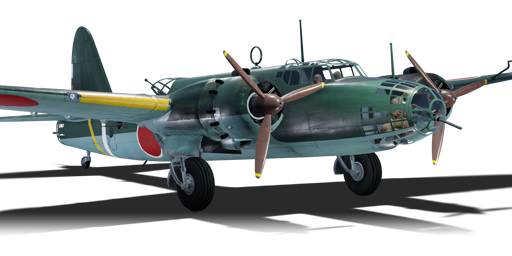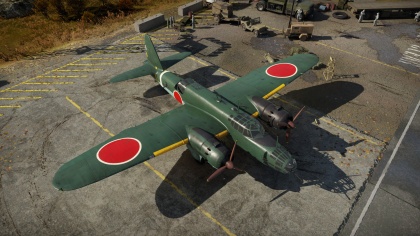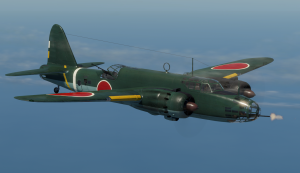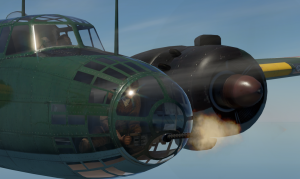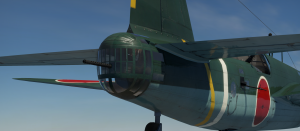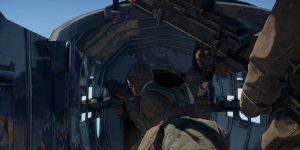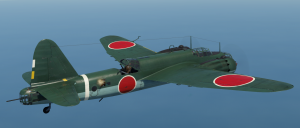Difference between revisions of "Ki-49-IIb/L"
(→General info) (Tag: Visual edit) |
(Edits) |
||
| Line 13: | Line 13: | ||
The Ki-49's role is a low-altitude light bomber capable of destroying ground targets such as pillboxes and tanks. Although hindered by a low total bomb capacity, this aircraft is renowned for its impressive manoeuvrability. This being said, it is very easy for the Ki-49 to hover above an area and drop all of its payloads rather quickly. Heavy bombers such as the G8N1 Renzan have a harder time due to their sheer size and slow rate of turn. Make sure to select the 4 x 250 kg bomb loadouts if attacking targets like tanks, pillboxes, or smaller ships. | The Ki-49's role is a low-altitude light bomber capable of destroying ground targets such as pillboxes and tanks. Although hindered by a low total bomb capacity, this aircraft is renowned for its impressive manoeuvrability. This being said, it is very easy for the Ki-49 to hover above an area and drop all of its payloads rather quickly. Heavy bombers such as the G8N1 Renzan have a harder time due to their sheer size and slow rate of turn. Make sure to select the 4 x 250 kg bomb loadouts if attacking targets like tanks, pillboxes, or smaller ships. | ||
| − | |||
| − | |||
== General info == | == General info == | ||
=== Flight performance === | === Flight performance === | ||
''Describe how the aircraft behaves in the air. Speed, manoeuvrability, acceleration and allowable loads - these are the most important characteristics of the vehicle.'' | ''Describe how the aircraft behaves in the air. Speed, manoeuvrability, acceleration and allowable loads - these are the most important characteristics of the vehicle.'' | ||
| + | [[File:Ki-49-IIb L firing defensive Type 89.png|thumb|Ki-49-IIb/L firing the [[Type 89 (7.7 mm)|Type 89]] defensive turret.]] | ||
| − | {| class="wikitable" style="text-align:center" | + | {| class="wikitable" style="text-align:center" width="70%" |
! rowspan="2" | Characteristics | ! rowspan="2" | Characteristics | ||
! colspan="2" | Max Speed<br>(km/h at 5,150 m) | ! colspan="2" | Max Speed<br>(km/h at 5,150 m) | ||
| − | ! rowspan="2" | Max altitude<br>( | + | ! rowspan="2" | Max altitude<br>(metres) |
! colspan="2" | Turn time<br>(seconds) | ! colspan="2" | Turn time<br>(seconds) | ||
| − | ! colspan="2" | Rate of climb<br>( | + | ! colspan="2" | Rate of climb<br>(metres/second) |
| − | ! rowspan="2" | Take-off run<br>( | + | ! rowspan="2" | Take-off run<br>(metres) |
|- | |- | ||
! AB !! RB !! AB !! RB !! AB !! RB | ! AB !! RB !! AB !! RB !! AB !! RB | ||
|- | |- | ||
! Stock | ! Stock | ||
| − | | 482 || 467 || rowspan="2" | {{Specs|ceiling}} || 31.0 || 31.8 || | + | | 482 || 467 || rowspan="2" | {{Specs|ceiling}} || 31.0 || 31.8 || 9.6 || 9.6 || rowspan="2" | 650 |
|- | |- | ||
! Upgraded | ! Upgraded | ||
| Line 39: | Line 38: | ||
==== Details ==== | ==== Details ==== | ||
| − | {| class="wikitable" style="text-align:center" | + | {| class="wikitable" style="text-align:center" width="50%" |
|- | |- | ||
! colspan="5" | Features | ! colspan="5" | Features | ||
| Line 49: | Line 48: | ||
|} | |} | ||
| − | {| class="wikitable" style="text-align:center" | + | {| class="wikitable" style="text-align:center" width="50%" |
|- | |- | ||
! colspan="7" | Limits | ! colspan="7" | Limits | ||
| Line 60: | Line 59: | ||
! Combat !! Take-off !! Landing !! + !! - | ! Combat !! Take-off !! Landing !! + !! - | ||
|- | |- | ||
| − | | {{Specs|destruction| | + | | {{Specs|destruction|body}} || {{Specs|destruction|gear}} || 450 || 450 || 250 || ~4 || ~2 |
|- | |- | ||
|} | |} | ||
| Line 98: | Line 97: | ||
* 12.5 mm Steel plate surrounded by a dorsal gunner | * 12.5 mm Steel plate surrounded by a dorsal gunner | ||
* 12.5 mm Steel plate in front of the tail gunner | * 12.5 mm Steel plate in front of the tail gunner | ||
| − | |||
| − | |||
== Armaments == | == Armaments == | ||
=== Suspended armament === | === Suspended armament === | ||
<!-- ''Describe the aircraft's suspended armament: additional cannons under the wings, bombs, rockets and torpedoes. This section is especially important for bombers and attackers. If there is no suspended weaponry remove this subsection.'' --> | <!-- ''Describe the aircraft's suspended armament: additional cannons under the wings, bombs, rockets and torpedoes. This section is especially important for bombers and attackers. If there is no suspended weaponry remove this subsection.'' --> | ||
| + | [[File:Ki-49-IIb L firing nose turret.png|thumb|Unlike the [[G4M1]] and [[Ki-21-Ia]], the Ki-49-IIb/L can fire its frontal turret at a slightly upwards angle and not just downards.]] | ||
{{main|Army Type 94 GPHE (50 kg)|Army Type 92 GPHE (250 kg)|Army Type 92 GPHE (500 kg)}} | {{main|Army Type 94 GPHE (50 kg)|Army Type 92 GPHE (250 kg)|Army Type 92 GPHE (500 kg)}} | ||
| Line 123: | Line 121: | ||
* 1 x 12.7 mm Ho-104 machine gun, tail turret (250 rpg) | * 1 x 12.7 mm Ho-104 machine gun, tail turret (250 rpg) | ||
* 1 x 7.7 mm Type 89 machine gun, 2 x beam turrets (414 rpg) | * 1 x 7.7 mm Type 89 machine gun, 2 x beam turrets (414 rpg) | ||
| − | |||
| − | |||
== Usage in battles == | == Usage in battles == | ||
<!-- ''Describe the tactics of playing in the aircraft, the features of using aircraft in a team and advice on tactics. Refrain from creating a "guide" - do not impose a single point of view, but instead, give the reader food for thought. Examine the most dangerous enemies and give recommendations on fighting them. If necessary, note the specifics of the game in different modes (AB, RB, SB).'' --> | <!-- ''Describe the tactics of playing in the aircraft, the features of using aircraft in a team and advice on tactics. Refrain from creating a "guide" - do not impose a single point of view, but instead, give the reader food for thought. Examine the most dangerous enemies and give recommendations on fighting them. If necessary, note the specifics of the game in different modes (AB, RB, SB).'' --> | ||
| + | [[File:Ki-49-IIb L firing nose turret close-up.png|thumb|The front gunner will be an important asset in RB. Once you have expended the bomb payload, this gunner can take out soft ground targets.]] | ||
This aircraft has the ability to hold up to 1,000 kg of bombs in several different variations. 12 x 50 kg bombs, 4 x 250 kg bombs, 1 x 500 kg bomb. Use the 12 x 50 kg bombs to attack light tanks and light pillboxes. They are not viable against bigger targets since direct hits are needed to destroy. This payload is particularly useful on maps like Zhengzhou where there is an abundance on non-moving targets (light pillboxes). Use the 4 x 250 kg bomb versions to destroy heavier targets such as medium tanks, pillboxes, destroyers, and cargo ships. Use the 500 kg bomb to destroy targets like carriers or mini-bases. | This aircraft has the ability to hold up to 1,000 kg of bombs in several different variations. 12 x 50 kg bombs, 4 x 250 kg bombs, 1 x 500 kg bomb. Use the 12 x 50 kg bombs to attack light tanks and light pillboxes. They are not viable against bigger targets since direct hits are needed to destroy. This payload is particularly useful on maps like Zhengzhou where there is an abundance on non-moving targets (light pillboxes). Use the 4 x 250 kg bomb versions to destroy heavier targets such as medium tanks, pillboxes, destroyers, and cargo ships. Use the 500 kg bomb to destroy targets like carriers or mini-bases. | ||
If attacked by fighters, it is important to remember and recognize the Ki-49's turning capabilities. It is actually possible to win lateral turn fights against fighters with this aircraft '''<u>IN ARCADE BATTLES</u>'''. Try not to act like a "sitting duck" because the Ki-49 features little armour protection and has limited defensive capabilities as far as weapons go. If you are in a sticky situation, the hard-hitting 20 mm dorsal cannon is deadly. The only problem is that it's not located directly on the tail. If an enemy is directly behind or below the Ki-49, the 20 mm tail gunner's arc will not reach it. Therefore, you may need to change altitude in order to have the enemy plane both above and behind you. Pulling hard manoeuvres will throw the enemy off and allow you to set up for more defensive fire. | If attacked by fighters, it is important to remember and recognize the Ki-49's turning capabilities. It is actually possible to win lateral turn fights against fighters with this aircraft '''<u>IN ARCADE BATTLES</u>'''. Try not to act like a "sitting duck" because the Ki-49 features little armour protection and has limited defensive capabilities as far as weapons go. If you are in a sticky situation, the hard-hitting 20 mm dorsal cannon is deadly. The only problem is that it's not located directly on the tail. If an enemy is directly behind or below the Ki-49, the 20 mm tail gunner's arc will not reach it. Therefore, you may need to change altitude in order to have the enemy plane both above and behind you. Pulling hard manoeuvres will throw the enemy off and allow you to set up for more defensive fire. | ||
| − | In ''' | + | In '''Arcade battles''', this aircraft is particularly proficient at bombing bases, especially with a maxed reload crew skill. Since the Ki-49 can virtually turn on a dime, instead of having to line up longer bombing runs like heavy bombers you can "hover" over the base or airfield and attempt dive attacks. The 500 kg bomb is particularly useful here because you only have to drop one bomb instead of spamming multiple. It's also possible to use this same tactic against pillboxes or tanks. With fighter cover, a good reload time skill and good aim it's possible to destroy dozens of ground units. |
Although unconventional, this aircraft is a fantastic weapon if you want to bait the enemy. Ideally, you would want to attract a higher flying enemy down to you and to get into a turn fight. This way, depending on the enemy aircraft you can outmanoeuvre and distract him while teammates fly down to finish him off. | Although unconventional, this aircraft is a fantastic weapon if you want to bait the enemy. Ideally, you would want to attract a higher flying enemy down to you and to get into a turn fight. This way, depending on the enemy aircraft you can outmanoeuvre and distract him while teammates fly down to finish him off. | ||
| Line 138: | Line 135: | ||
The best way of grinding with this aircraft is to play cautiously and to use communication. As with any bomber, if you're caught alone or off guard you are as good as dead. Although not a sure tactic, having a fighter escort will boost RP gains drastically. This goes for both Arcade and Realistic battles. Generally, try to destroy as many targets as possible without wasting bombs. If done in a speedy fashion it is possible to drop multiple payloads in RB. The same goes for simulator battles. In Arcade battles, having a high reload speed and a fighter escort will allow for constant bombardment. If done correctly, flying the Ki-49 in all modes will net you large amounts of RP. | The best way of grinding with this aircraft is to play cautiously and to use communication. As with any bomber, if you're caught alone or off guard you are as good as dead. Although not a sure tactic, having a fighter escort will boost RP gains drastically. This goes for both Arcade and Realistic battles. Generally, try to destroy as many targets as possible without wasting bombs. If done in a speedy fashion it is possible to drop multiple payloads in RB. The same goes for simulator battles. In Arcade battles, having a high reload speed and a fighter escort will allow for constant bombardment. If done correctly, flying the Ki-49 in all modes will net you large amounts of RP. | ||
| − | In ''' | + | In '''Realistic Battles''', your gunners might deter the stray fighter, but won't deter a horde of them. American fighters think you are the perfect target for .50 caliber machine guns. What to do? Wait out the battle patiently. In all Realistic Battles, fights will get dragged to lower altitudes, and you can start climbing and head into the main are once you are high enough. One other strategy is to rush attack. Take out the 250kg bombs and destroy four Pillboxes and then run back to base immediately to restock. This will allow for fighter support to come to you while you head back to base. |
=== Manual Engine Control === | === Manual Engine Control === | ||
| Line 195: | Line 192: | ||
Being a bomber, speed is not necessarily an important attribute, however, payload and armament are. Upgrading the bombs allows for more target flexibility and damage potential while turret upgrades will help survivability. The turret belts and the "new turrets" upgrades are useful. The "new turrets" upgrade will allow you to fire the turrets for longer periods of time and having access to multiple ammunition belts is also helpful. The engine upgrades are also useful in that they will help you reach your target faster and will control engine temperature. Having all of the weapons upgrades will help drastically in unlocking the other modules on this aircraft. | Being a bomber, speed is not necessarily an important attribute, however, payload and armament are. Upgrading the bombs allows for more target flexibility and damage potential while turret upgrades will help survivability. The turret belts and the "new turrets" upgrades are useful. The "new turrets" upgrade will allow you to fire the turrets for longer periods of time and having access to multiple ammunition belts is also helpful. The engine upgrades are also useful in that they will help you reach your target faster and will control engine temperature. Having all of the weapons upgrades will help drastically in unlocking the other modules on this aircraft. | ||
| − | |||
| − | |||
=== Pros and cons === | === Pros and cons === | ||
<!-- ''Summarise and briefly evaluate the vehicle in terms of its characteristics and combat effectiveness. Mark its pros and cons in the bulleted list. Try not to use more than 6 points for each of the characteristics. Avoid using categorical definitions such as "bad", "good" and the like - use substitutions with softer forms such as "inadequate" and "effective".'' --> | <!-- ''Summarise and briefly evaluate the vehicle in terms of its characteristics and combat effectiveness. Mark its pros and cons in the bulleted list. Try not to use more than 6 points for each of the characteristics. Avoid using categorical definitions such as "bad", "good" and the like - use substitutions with softer forms such as "inadequate" and "effective".'' --> | ||
| + | [[File:Ki-49-IIb L tail turret.png|thumb|The back gunner on the Ki-49-IIb/L is well protected, addressing issues with the [[G4M1]] and [[Ki-21-Ia]].]] | ||
'''Pros:''' | '''Pros:''' | ||
| Line 215: | Line 211: | ||
* Generally poor defensive armament | * Generally poor defensive armament | ||
* Low rate of climb | * Low rate of climb | ||
| − | |||
| − | |||
== History == | == History == | ||
<!-- ''Describe the history of the creation and combat usage of the aircraft in more detail than in the introduction. If the historical reference turns out to be too long, take it to a separate article, taking a link to the article about the vehicle and adding a block "/History" (example: <nowiki>https://wiki.warthunder.com/(Vehicle-name)/History</nowiki>) and add a link to it here using the <code>main</code> template. Be sure to reference text and sources by using <code><nowiki><ref></ref></nowiki></code>, as well as adding them at the end of the article with <code><nowiki><references /></nowiki></code>. This section may also include the vehicle's dev blog entry (if applicable) and the in-game encyclopedia description (under <code><nowiki>=== In-game description ===</nowiki></code>, also if applicable).'' --> | <!-- ''Describe the history of the creation and combat usage of the aircraft in more detail than in the introduction. If the historical reference turns out to be too long, take it to a separate article, taking a link to the article about the vehicle and adding a block "/History" (example: <nowiki>https://wiki.warthunder.com/(Vehicle-name)/History</nowiki>) and add a link to it here using the <code>main</code> template. Be sure to reference text and sources by using <code><nowiki><ref></ref></nowiki></code>, as well as adding them at the end of the article with <code><nowiki><references /></nowiki></code>. This section may also include the vehicle's dev blog entry (if applicable) and the in-game encyclopedia description (under <code><nowiki>=== In-game description ===</nowiki></code>, also if applicable).'' --> | ||
| + | [[File:Ki-49-IIb L gunner compartment.png|thumb|Ki-49-IIb/L's gunner compartment, which houses the [[Type 89 (7.7 mm)|Type 89]] gunners as well as the lower [[Ho-103 (12.7 mm)|Ho-103]] gunner.]] | ||
;Nakajima Ki-49-II Donryu Army Bomber, type 100 model 2 (code name "''Helen''") | ;Nakajima Ki-49-II Donryu Army Bomber, type 100 model 2 (code name "''Helen''") | ||
| Line 236: | Line 231: | ||
=== In-game description === | === In-game description === | ||
| − | Nakajima Ki-49-II Donryu Army Bomber, type 100 model 2 (code name | + | Nakajima Ki-49-II Donryu Army Bomber, type 100 model 2 (code name "Helen") |
In the spring of 1942, it was decided that the Ki-49 should be fitted with new engines, the Nakajima Ha-109 radial piston engines, rated at 1450 hp. This required only a slight modification of the engine nacelles, as the new engine was a similar size to that of its predecessor. However, the oil cooler could not fit inside the nacelle along with the engine and was put outside, instead. Other changes were made to improve combat conditions: the armor protecting the airplane's crew was upgraded and self-sealing fuel tanks were installed, as well as a new bomb sight. | In the spring of 1942, it was decided that the Ki-49 should be fitted with new engines, the Nakajima Ha-109 radial piston engines, rated at 1450 hp. This required only a slight modification of the engine nacelles, as the new engine was a similar size to that of its predecessor. However, the oil cooler could not fit inside the nacelle along with the engine and was put outside, instead. Other changes were made to improve combat conditions: the armor protecting the airplane's crew was upgraded and self-sealing fuel tanks were installed, as well as a new bomb sight. | ||
| Line 253: | Line 248: | ||
== Media == | == Media == | ||
| − | + | <!-- ''Excellent additions to the article would be video guides, screenshots from the game, and photos.'' --> | |
| − | [[File: | + | [[File:Ki-49-IIb L in flight.png|thumb|none|Ki-49-IIb/L in flight]] |
== See also == | == See also == | ||
''Links to the articles on the War Thunder Wiki that you think will be useful for the reader, for example:'' | ''Links to the articles on the War Thunder Wiki that you think will be useful for the reader, for example:'' | ||
| − | |||
* ''reference to the series of the aircraft;'' | * ''reference to the series of the aircraft;'' | ||
* ''links to approximate analogues of other nations and research trees.'' | * ''links to approximate analogues of other nations and research trees.'' | ||
Revision as of 18:34, 4 August 2020
Contents
| This page is about the Japanese medium bomber Ki-49-IIb/L. For other versions, see Ki-49 (Family). |
Description
The Ki-49-IIb Donryu /Late is a rank III Japanese bomber
with a battle rating of 3.7 (AB/RB) and 4.0 (SB). It has been in the game since the start of the Open Beta Test prior to Update 1.27.
The Ki-49's role is a low-altitude light bomber capable of destroying ground targets such as pillboxes and tanks. Although hindered by a low total bomb capacity, this aircraft is renowned for its impressive manoeuvrability. This being said, it is very easy for the Ki-49 to hover above an area and drop all of its payloads rather quickly. Heavy bombers such as the G8N1 Renzan have a harder time due to their sheer size and slow rate of turn. Make sure to select the 4 x 250 kg bomb loadouts if attacking targets like tanks, pillboxes, or smaller ships.
General info
Flight performance
Describe how the aircraft behaves in the air. Speed, manoeuvrability, acceleration and allowable loads - these are the most important characteristics of the vehicle.
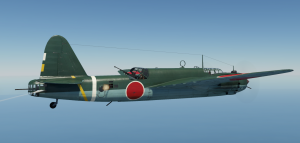
| Characteristics | Max Speed (km/h at 5,150 m) |
Max altitude (metres) |
Turn time (seconds) |
Rate of climb (metres/second) |
Take-off run (metres) | |||
|---|---|---|---|---|---|---|---|---|
| AB | RB | AB | RB | AB | RB | |||
| Stock | 482 | 467 | 9300 | 31.0 | 31.8 | 9.6 | 9.6 | 650 |
| Upgraded | 525 | 502 | 29.0 | 30.0 | 16.1 | 12.5 | ||
Details
| Features | ||||
|---|---|---|---|---|
| Combat flaps | Take-off flaps | Landing flaps | Air brakes | Arrestor gear |
| ✓ | ✓ | ✓ | X | X |
| Limits | ||||||
|---|---|---|---|---|---|---|
| Wings (km/h) | Gear (km/h) | Flaps (km/h) | Max Static G | |||
| Combat | Take-off | Landing | + | - | ||
| 0 | 300 | 450 | 450 | 250 | ~4 | ~2 |
| Optimal velocities (km/h) | |||
|---|---|---|---|
| Ailerons | Rudder | Elevators | Radiator |
| < 260 | < 360 | < 350 | > 334 |
| Compressor | Optimal altitude | 100% Engine power | WEP Engine power |
|---|---|---|---|
| Setting 1 | 2,150 m | 1,420 hp | 1,613 hp |
| Setting 2 | 5,240 m | 1,300 hp | 1,477 hp |
Survivability and armour
- 68 mm Bulletproof glass in front of pilots
- 16.5 mm Steel plate behind the pilots
- 12.5 mm Steel plate behind nose gunner
- 12.5 mm Steel plate on the fuselage top
- 12.5 mm Steel plate surrounded by a dorsal gunner
- 12.5 mm Steel plate in front of the tail gunner
Armaments
Suspended armament
The Ki-49-IIb/L can be outfitted with the following ordnance:
- 12 x 50 kg Army Type 94 GPHE bombs (600 kg total)
- 4 x 250 kg Army Type 92 GPHE bombs (1,000 kg total)
- 1 x 500 kg Army Type 92 GPHE bomb (500 kg total)
Defensive armament
The Ki-49-IIb/L is defended by:
- 1 x 20 mm Ho-1 cannon, dorsal turret (180 rpg)
- 1 x 12.7 mm Ho-104 machine gun, nose turret (250 rpg)
- 1 x 12.7 mm Ho-104 machine gun, ventral turret (250 rpg)
- 1 x 12.7 mm Ho-104 machine gun, tail turret (250 rpg)
- 1 x 7.7 mm Type 89 machine gun, 2 x beam turrets (414 rpg)
Usage in battles
This aircraft has the ability to hold up to 1,000 kg of bombs in several different variations. 12 x 50 kg bombs, 4 x 250 kg bombs, 1 x 500 kg bomb. Use the 12 x 50 kg bombs to attack light tanks and light pillboxes. They are not viable against bigger targets since direct hits are needed to destroy. This payload is particularly useful on maps like Zhengzhou where there is an abundance on non-moving targets (light pillboxes). Use the 4 x 250 kg bomb versions to destroy heavier targets such as medium tanks, pillboxes, destroyers, and cargo ships. Use the 500 kg bomb to destroy targets like carriers or mini-bases.
If attacked by fighters, it is important to remember and recognize the Ki-49's turning capabilities. It is actually possible to win lateral turn fights against fighters with this aircraft IN ARCADE BATTLES. Try not to act like a "sitting duck" because the Ki-49 features little armour protection and has limited defensive capabilities as far as weapons go. If you are in a sticky situation, the hard-hitting 20 mm dorsal cannon is deadly. The only problem is that it's not located directly on the tail. If an enemy is directly behind or below the Ki-49, the 20 mm tail gunner's arc will not reach it. Therefore, you may need to change altitude in order to have the enemy plane both above and behind you. Pulling hard manoeuvres will throw the enemy off and allow you to set up for more defensive fire.
In Arcade battles, this aircraft is particularly proficient at bombing bases, especially with a maxed reload crew skill. Since the Ki-49 can virtually turn on a dime, instead of having to line up longer bombing runs like heavy bombers you can "hover" over the base or airfield and attempt dive attacks. The 500 kg bomb is particularly useful here because you only have to drop one bomb instead of spamming multiple. It's also possible to use this same tactic against pillboxes or tanks. With fighter cover, a good reload time skill and good aim it's possible to destroy dozens of ground units.
Although unconventional, this aircraft is a fantastic weapon if you want to bait the enemy. Ideally, you would want to attract a higher flying enemy down to you and to get into a turn fight. This way, depending on the enemy aircraft you can outmanoeuvre and distract him while teammates fly down to finish him off.
The best way of grinding with this aircraft is to play cautiously and to use communication. As with any bomber, if you're caught alone or off guard you are as good as dead. Although not a sure tactic, having a fighter escort will boost RP gains drastically. This goes for both Arcade and Realistic battles. Generally, try to destroy as many targets as possible without wasting bombs. If done in a speedy fashion it is possible to drop multiple payloads in RB. The same goes for simulator battles. In Arcade battles, having a high reload speed and a fighter escort will allow for constant bombardment. If done correctly, flying the Ki-49 in all modes will net you large amounts of RP.
In Realistic Battles, your gunners might deter the stray fighter, but won't deter a horde of them. American fighters think you are the perfect target for .50 caliber machine guns. What to do? Wait out the battle patiently. In all Realistic Battles, fights will get dragged to lower altitudes, and you can start climbing and head into the main are once you are high enough. One other strategy is to rush attack. Take out the 250kg bombs and destroy four Pillboxes and then run back to base immediately to restock. This will allow for fighter support to come to you while you head back to base.
Manual Engine Control
| MEC elements | ||||||
|---|---|---|---|---|---|---|
| Mixer | Pitch | Radiator | Supercharger | Turbocharger | ||
| Oil | Water | Type | ||||
| Not controllable | Controllable Auto control available |
Not controllable Not auto controlled |
Controllable Not auto controlled |
Combined | Controllable 2 gears |
Not controllable |
Modules
| Tier | Flight performance | Survivability | Weaponry | ||
|---|---|---|---|---|---|
| I | Fuselage repair | Radiator | Turret 7 mm 12 in (mod30) | ||
| II | Compressor | Airframe | New 7 mm MGs (turret) | 14 in (mod35) | |
| III | Wings repair | Engine | Turret 12 mm | Turret 20 mm | |
| IV | Engine injection | Cover | New 12 mm MGs (turret) | New 20 mm cannons (turret) | |
Being a bomber, speed is not necessarily an important attribute, however, payload and armament are. Upgrading the bombs allows for more target flexibility and damage potential while turret upgrades will help survivability. The turret belts and the "new turrets" upgrades are useful. The "new turrets" upgrade will allow you to fire the turrets for longer periods of time and having access to multiple ammunition belts is also helpful. The engine upgrades are also useful in that they will help you reach your target faster and will control engine temperature. Having all of the weapons upgrades will help drastically in unlocking the other modules on this aircraft.
Pros and cons
Pros:
- Very good manoeuvrability and turn time for a bomber
- Variety of payload options
- Multiple gunners for protection in almost all directions
- Some armour protection around pilots and gunners
Cons:
- Prone to engine and fuel fires
- Relatively slow
- Low total bomb capacity (1,000 kg)
- Generally poor defensive armament
- Low rate of climb
History
- Nakajima Ki-49-II Donryu Army Bomber, type 100 model 2 (code name "Helen")
Prior to the outbreak of the War in the Pacific, the Japanese utilised the Ki-49 in China where it served well. It wasn't until the spring of 1942 that the Japanese military determined that the Ki-49 should be fitted with upgraded engines, namely the Nakajima Ha-109 radial piston engines which were rated at 1450 hp. Upgrading the engines, however, required slight modification of the engine nacelles to accommodate the newer engines even though they were roughly the same size as the original engines. Unfortunately, the oil cooler would not fit inside the nacelle along with the new engine and was instead mounted on the exterior of the nacelle. Other changes were also made to improve combat conditions of this aircraft: upgraded armour protection protecting the aircrew was installed along with self-sealing fuel tanks and a bombsight. The defensive armament remained similar to that of the Ki-49-I, however, the Type 89 machine guns were replaced with Type 98 7.92 mm machine guns (which were based on the Rheinmetall-Borsig MG.15). The normal bomb-carrying capacity of the aircraft was increased to 1,000 kg. A few short months later in August of 1942, this new version of the Donryu entered production under the designation Ki-49-IIa (model 2 Ko).
Quickly it was determined that the defensive machine guns were proven to be ineffective against Allied fighters and this required a new modification, which became the Ki-49-IIb (model 2 Otsu) implemented with stronger defensive weaponry. In the bow, stern, and ventral firing positions, the Type 98 7.92 mm machine guns were replaced with Ho-103 12.7 mm machine guns (the Type 1 Japanese version of the Browning M2 .50 calibre machine guns). The two guns on the aircraft's sides were replaced with the original Type 89 7.7mm machine guns removed during the Ki-49-Ia upgrade. The bomb load remained unchanged at 1,000 kg. In later series, the Ki-49-IIb's common exhaust tube was replaced with several individual pipes. Even though the Ki-49-II bombers went through several revisions and upgrades, they were unable to completely replace the older models still in service. These bombers were used mainly in New Guinea, and China, and, in October of 1944, they were transferred to the Philippines where they actively participated in the Battle of Leyte Gulf. The Ki-49 was utilised as a jack-of-all-trades aircraft as she was used as both a day and a night bomber, long-range reconnaissance, transport, and anti-submarine patrols to name a few. Towards the end of the war, the Ki-49s were assigned to kamikaze units and modified for such action. Modifications for the kamikaze missions included stripping out all of the defensive armaments, the crew was reduced to two pilots and the bomb load was increased to 1,600 kg. Production of the Ki-49 ceased in December of 1944. In all its different variants, a total of 819 Ki-49s were constructed.
The first unit to receive Donryus was the 61st Sentai in China. An unknown amount of Ki-49s was involved in the Battle of Okinawa in 1945.
- 95th Sentai, Papua New Guinea 1943
- 61st Sentai, French Indochina 1944
- 7th Sentai, 2nd Chutai 1944-45
- 24th Sentai, 2nd Chutai Philippines 1944-45
- 62st Sentai 3rd Chutai Burma 1944
In-game description
Nakajima Ki-49-II Donryu Army Bomber, type 100 model 2 (code name "Helen")
In the spring of 1942, it was decided that the Ki-49 should be fitted with new engines, the Nakajima Ha-109 radial piston engines, rated at 1450 hp. This required only a slight modification of the engine nacelles, as the new engine was a similar size to that of its predecessor. However, the oil cooler could not fit inside the nacelle along with the engine and was put outside, instead. Other changes were made to improve combat conditions: the armor protecting the airplane's crew was upgraded and self-sealing fuel tanks were installed, as well as a new bomb sight.
The defensive armament remained similar to that of the Ki-49-I, but the Type 89 machine guns were replaced with Type 98 7.92 mm machine guns (which were based on the Rheinmetall-Borsig MG.15). Normal bomb carrying capacity was increased to 1000 kilograms.
In August of 1942, the new version of the Donryu entered production, under the designation Ki-49-IIa (model 2Ko). However, the fighters' machine guns were soon proven to be ineffective against Allied fighters, so a new modification, the Ki-49-IIb (model 2Otsu) was designed with stronger defensive weaponry. In the bow, stern, and lower firing locations, the Type 98 7.92 mm machine guns were replaced with Ho-103 12.7 mm machine guns (the Type 1 Japanese version of the Browning M2.50). The two guns on the aircraft's sides were replaced with the original Type 89 7.7 mm machine guns. The bomb load remained unchanged.
In later series, the Ki-49-IIb's common exhaust was replaced with several separate pipes.
The Ki-49-II bombers were unable to completely replace the older models in service. They were used mainly in New Guinea and China, and, in October of 1944, they took active participation in the Battle of Leyte.
The Ki-49 was used as both a day and a night bomber as well as for long-range reconnaissance, transport, and anti-submarine patrols. Towards the end of the war, they were used in kamikaze units. For kamikaze missions, the Ki-49 was stripped of all defensive armaments, the crew was reduced to two pilots, and the bomb load was increased to 1600 kilograms.
Production of the Ki-49 ceased in December of 1944. In all, 819 Ki-49s were constructed, including all variants.
Media
See also
Links to the articles on the War Thunder Wiki that you think will be useful for the reader, for example:
- reference to the series of the aircraft;
- links to approximate analogues of other nations and research trees.
External links
- [Military Factory] Nakajima Ki-49 Donryu (Helen)
- [Pilot Friend] Nakajima Ki 49 Helen
- [Wings Palette] Nakajima Ki-49 Donryu/Helen
| Nakajima Aircraft Company (中島飛行機株式会社 ) | |
|---|---|
| Fighters | Ki-27 otsu · Ki-27 otsu Tachiarai |
| Ki-43-I · Ki-43-II · Ki-43-III otsu | |
| Ki-44-I · Ki-44-I 34 · Ki-44-II otsu · Ki-44-II hei | |
| Ki-84 ko · Ki-84 otsu · Ki-84 hei | |
| Ki-87 | |
| Hydroplanes | A6M2-N* |
| Interceptors | J1N1 · J5N1 |
| Bombers | B5N2 |
| B6N1 Model 11 · B6N2 Model 12 · B6N2a Model 12Ko | |
| G5N1 · G8N1 | |
| Ki-49-I · Ki-49-IIa · Ki-49-IIb · Ki-49-IIb/L | |
| Recon | E8N2 |
| Jet Fighters | Kikka |
| Captured | ␗Ki-27 otsu · ▃Ki-43-II · ␗Ki-43-III ko · ␗Ki-44-II hei · ␗Ki-84 ko |
| *Refit of the Mitsubishi A6M2 mod. 11 | |
| See also | Fuji Heavy Industries (1957-2017) |
| Japan bombers | |
|---|---|
| Navy | |
| Carrier-based attack bomber | |
| B5N | B5N2 |
| B6N | B6N1 · B6N2 · B6N2a |
| B7A | B7A2 · B7A2 (Homare 23) |
| Carrier-based dive bomber | |
| D3A | D3A1 |
| D4Y | D4Y1 · D4Y2 · D4Y3 Ko |
| Shipboard Observation seaplane | |
| F1M | F1M2 |
| Land-based Attack bomber | |
| G4M | G4M1 |
| G5N | G5N1 |
| G8N | G8N1 |
| Flying boat | |
| H6K | H6K4 |
| H8K | H8K2 · H8K3 |
| Land-based Bomber | |
| P1Y | P1Y1 |
| Army | |
| Light | Ki-32 |
| Ki-48-II otsu | |
| Heavy | Ki-21-Ia · Ki-21-I hei |
| Ki-49-I · Ki-49-IIa · Ki-49-IIb · Ki-49-IIb/L | |
| Ki-67-I Ko · Ki-67-I otsu | |
| Other countries | ▅B-17E |


